Prime real estate: What will $10 million buy?

The rich are different from you and me. So are their houses, and how their houses are bought and sold.
Even in a stagnant real estate market where the most action is in the under-$300K range, 10 houses in Albemarle County are listed for sale for $10 million or more.
Back in 2001, local jaws dropped when soon-to-be convicted Tyco swindler Mark Swartz laid out a reported $17 million for historic Enniscorthy and its 1,400 acres in Keene. That record was soon surpassed in 2005 when Castle Hill and its 1,200 acres sold for $24 million. Now it's 2010, and Castle Hill is back on the market with a slimmer 601 acres for $14.5 million.
After a decade of $10 million-plus sales– Chapel Springs for an estimated $16 million, Bundoran Farm for $33 million– we were getting sort of blase about multi-million dollar sales. And then Patricia Kluge listed Albemarle House for $100 million, making it the grande dame of the over-$10-million listing set.
So what does $10 million buy?
"One is not just buying a piece of property," observes Ross Stevens, who has two listings in that category. "They're buying a lifestyle."
Charlottesville's best-place-to-live status is well known. He cites its four distinct seasons, proximity to Washington, the Outer Banks and ski resorts, and its historical university town with a Blue Ridge Mountain backdrop. "The teaching hospital is a big plus," he adds. "People can look at retiring here."
"For $10 million plus, you get a lot relative to other desirable locations in the country," says Jim Faulconer, who has currently has three listings in that price range. He points out that while a house in Malibu or Montecito can cost $10 million, "here you can get a whole estate for that."
When you buy in the upper echelons of the market, the estate will have a name. It'll have a sign out front identifying it as Kinloch or Castle Hill. It will have a gate and a long driveway, buttressing it from the public thoroughfare.
Buyers expect a really quality house with well over 100 acres, says Faulconer, depending on the house's location. And location is always a factor. "Even large estates sell better if they're less than 15 miles from town," he says.
There are other amenities, besides swimming pools and tennis courts. In a horse-loving county with two hunt clubs, barn facilities are typical, as are other outbuildings to house the staff and equipment needed to maintain the estate.
"Privacy, views and location" are standard in the $10-million up range, says realtor Roger Voisinet. "The house is almost always updated, and it's probably going to be larger than what you need and not very energy efficient."
In an exceedingly slow real estate market, it would seem that any publicity would be welcome. Not at the rarefied end of the market. Broker Frank Hardy, who specializes in high-end properties, refused to speak to the Hook about the multi-millions in real estate he wants to sell.
The estates don't flaunt for-sale signs, and for further secrecy, one of Hardy's listings carries a fake address in the MLS.
"Obviously estates are by appointment only," says Stevens, who eschews for-sale signs on top-end properties. "Maybe they had a problem with a drive-by," he suggests.
Privacy is a concern not only for movie or rock stars, and LLCs– limited liability corporations– frequently help conceal ownership.
And a high-end agent makes sure that those taking a look at grand estates are serious buyers, not just nosy parkers– or newspaper reporters.
Once a buyer is found, forget the tedious haggling.
"Price isn't really a factor," says Justin Wiley, who's a listing agent for the aforementioned $14.5 million Castle Hill and the $13.5 million Old Keswick. It's more that "the buyers normally interested in this price point are holding back."
While normal folks may have to wait for a current home to sell or to get mortgage approval, the super-rich don't have such concerns.
"A lot of times, it's cash with no worry about contingencies," says Jim Bonner, president of the Land Office at Roy Wheeler.
And sellers can afford to wait, sometimes several years, without dropping the price, he says.
"I've had people who had to sell," says Bonner. "They discounted the price 30 percent." That creates a flurry of activity, because even the rich apparently like a bargain.
So who are these buyers who can pay cash for an eight-figure abode?
Certainly there are locals who can plunk down $15 million for a dwelling, but many of the estate buyers typically come from the northeast, urban areas, say agents. For a while Californians flooded the area, but that migration has slowed.
"When you've got all the rich Yankees liquidating assets and coming down here, money is no object," says attorney Fred Payne. "People with that magnitude of money are not as liquid as they used to be. They've realized [$10-million houses] are not a good investment."
And despite the past year's economic nosedive, Wall Street chugs on. "People are still getting paychecks and making a lot of money," says Jim Faulconer. But they're not necessarily looking for high-end homes in Albemarle County.
"It's very slow right now," reiterates Ross Stevens. "A lot our estate sales correlate with the stock market."
"It's pretty flat," echoes Jim Bonner. "Not many people are in that lofty category– and we never had a lot in that category."
He suggests caution, even among the well-heeled. "We're still seeing declines in the market," says Bonner. "Buyers are not keen on buying into a declining asset."
But when they do decide to take the plunge, there are plenty of multi-million properties out there, beckoning to be called home– even if it's the second or third one.
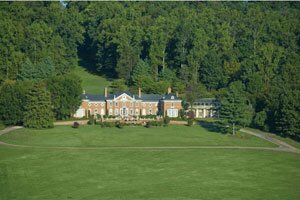
Sotheby's provides an aerial view of Albemarle's largest– and priciest– dwelling.
SOTHEBY'S WEBSITE
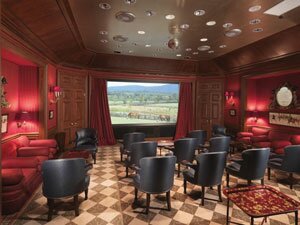
Enjoy a movie in the comfort of your own theater.
SOTHEBY'S WEBSITE
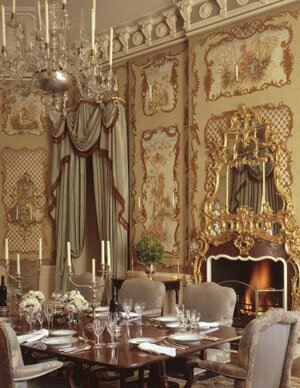
Dinner for 40? No problem.
SOTHEBY'S WEBSITE
Albemarle House
PRICE: $100,000,000
LOCATION: 355 Albemarle House Drive
SQUARE FOOTAGE: 23,000
ACRES: 300
OWNER: Patricia Kluge
ASSESSMENT: $17,336,300 (for 98 acres)
AGENT: Michael Rankin, Sotheby's International Realty
FEATURES: David Easton-designed Georgian built in 1985 with eight bedrooms, 13 bathrooms, a theater, a spa and sauna, and an Islamic gallery.
DISH: Not just the most expensive house in Albemarle, the estate is one of the priciest in the country. It more than doubles Albemarle's previous top sale, $46 million in 2005 for Biscuit Run, soon to be a state park. Odds of Kluge getting her asking price? "Let's see," says Stevens. "Let's look at what the most expensive [residential] sale has been, and it's only a quarter of that. Maybe a sheik. It's going to take a special person to use that type of space."

The house was built in 1975.
CAAR MLS PHOTO
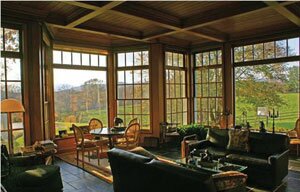
Plenty of privacy means no curtains necessary.
CAAR MLS PHOTO
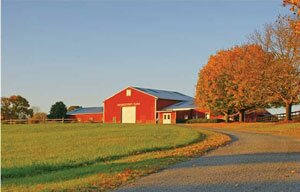
Georgetown Farm already has name recognition in grow-local circles.
CAAR MLS PHOTO
Georgetown Farm
PRICE: $17,000,000
LOCATION: 1921 Georgetown Farm, Free Union
SQUARE FOOTAGE: 7,850
ACRES: 636
OWNER: Edgar Bronfman
ASSESSMENT: $2,471,700
AGENT: Jim Faulconer, McLean Faulconer
FEATURES: Five bedrooms, eight full baths, tennis courts, pool.
DISH: Former Seagram's head Bronfman served as president of the World Jewish Congress and is the grandfather of songstress Lauren Hoffman. For a few years Georgetown Farm raised buffalo and beef that were sold to local restaurants and stores, as well as supplying a retail store at Albemarle Square. The buffalo no longer roam here, but the farm offers plenty of grazing room for whatever livestock the new owner fancies.
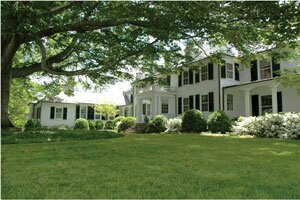
Kinloch boasts 10,000 square feet– but only three full baths, according to the MLS.
CAAR MLS PHOTO
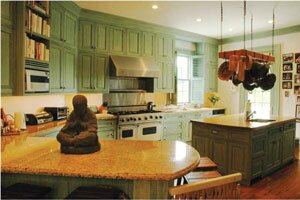
The serene kitchen at Kinloch.
CAAR MLS PHOTO
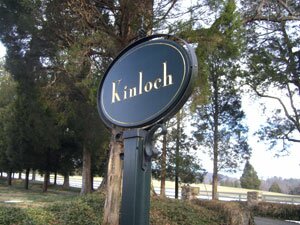
The $15 million price tag includes the estate sign.
PHOTO BY LISA PROVENCE
Kinloch
PRICE: $15,000,000
LOCATION: 1205 Kinloch Farm, Keswick
SQUARE FOOTAGE: 10,000
ACRES: 540
ASSESSMENT: $3,469,700
OWNERS: Bob and Janice Aron
AGENT: Frank Hardy, Frank Hardy Inc.
FEATURES: 1740-built house with horse barn and a conservation easement. Three baths and two half baths?
DISH: Hardy lists this property with a fictitious "0 Gordonsville Road" address, so the $15 mil property seems quietly for sale. The owners are members of the National Thoroughbred Racing Association and the location is in the heart of Keswick Hunt, just down the road from several other estates on the market.
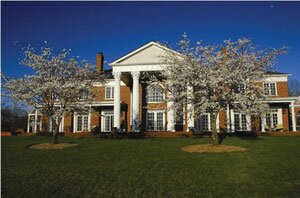
For a brief period, Emerald Hills' owner was a dot.com billionaire.
CAAR MLS PHOTO
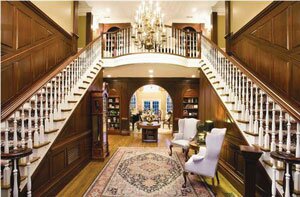
The double staircase is perfect for bannister-sliding races.
CAAR MLS PHOTO
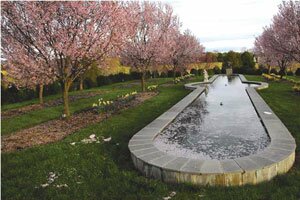
Emerald Hills in spring.
CAAR MLS PHOTO
Emerald Hills
PRICE: $14,950,000
LOCATION: 741 Woodlands Road
SQUARE FOOTAGE: 17,100
ACRES: 133
ASSESSMENT: $4,347,900 (for 50 acres)
OWNERS: Craig and Katharine Winn
AGENTS: Frank Hardy, Frank Hardy Inc., and Jim Faulconer, McLean Faulconer
FEATURES: Five bedrooms, 7 1/2 baths, close to town.
DISH: Value America founder Craig Winn built this manse in 1998, before the dot.com bubble popped and investors in his company found their stock shares worthless. Can't swing $14.95 million? Seventy acres are available for $11.95 million, and $9,950,000 buys 50 acres. Not in a conservation easement.
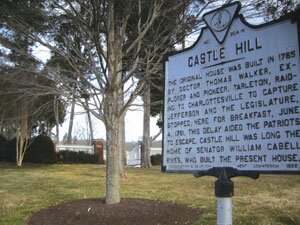
Castle Hill boasts its own historic marker.
PHOTO BY LISA PROVENCE
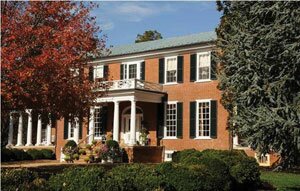
Author Amélie Rives married an Astor descendant in 1888 who helped provide funds to maintain Castle Hill. Their story is the subject of Donna Lucey's Archie and Amélie: Love and Madness in the Gilded Age.
CAAR MLS PHOTO
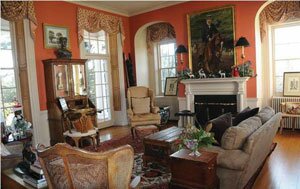
Soak up the history in the apricot parlor.
CAAR MLS PHOTO
Castle Hill
PRICE: $14,500,000
LOCATION: 6132 Gordonsville Road, Keswick
SQUARE FOOTAGE: 8,551
ACRES: 601
ASSESSMENT: $3,665,000
OWNER: Route 231 LLC
AGENTS: Frank Hardy and Justin Wiley, Frank Hardy Inc.
FEATURES: Formal gardens, National Register of Historic Places, Virginia Landmarks Register.
DISH: The 1765 historic estate built by Dr. Thomas Walker figures prominently in Albemarle's history dating back to the Revolutionary War, when a leisurely breakfast served to Lieutenant Colonel Banastre Tarleton allowed Jack Jouett to make his famous ride and alert Governor Thomas Jefferson that the British were coming. In 2005, its sale became the largest deal thus far when John D. Carr and Raymond E. Humiston III paid $24 million for 1,200 acres, which they put in a conservation easement. "It's the perfect colonial house joined to the perfect federal house," says Wiley.
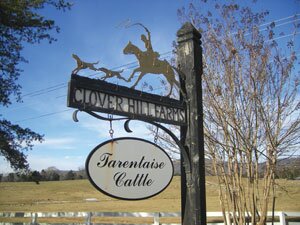
Clover Hill has one of the better estate signs.
PHOTO BY LISA PROVENCE
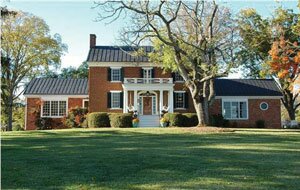
Clover Hill was built in 1860.
CAAR MLS PHOTO
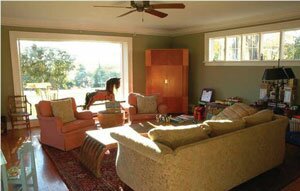
Even $14.5 million houses can feel cozy.
CAAR MLS PHOTO
Clover Hill Farm
PRICE: $14,500,000
LOCATION: 300 Clover Hill Farm, Keswick
SQUARE FOOTAGE: 4,415
ACRES: 477
ASSESSMENT: $1,495,900
OWNER: C&C LLC
AGENT: Frank Hardy
FEATURES: Three bedrooms, two full bathrooms.
DISH: If the number of bedrooms and baths sound modest, don't worry, three guest houses can accommodate visitors. The Bloch family sold Clover Hill for $13 million in 2006.
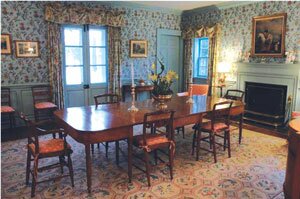
The entrance to Old Keswick makes a statement.
PHOTO BY LISA PROVENCE
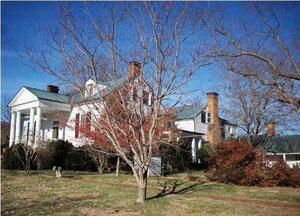
The original house dates to 1736.
CAAR MLS PHOTO

Historic house, period four-poster bed.
CAAR MLS PHOTO
Old Keswick
PRICE: $13,500,000
LOCATION: 2262 Old Keswick
SQUARE FOOTAGE: 8,500
ACRES: 546
ASSESSMENT: $2,481,500
OWNER: Peggy Augustus
AGENTS: Justin Wiley and Frank Hardy, Frank Hardy Inc.
FEATURES: Seven bedrooms, six full baths, top-notch equestrian facility.
DISH: The original 1736 structure was built by Castle Hill's Thomas Walker and thought to be a hunting lodge, and the front porch is believed to have been designed by Thomas Jefferson, says Wiley. "Keswick Stables is very well known in the horse world," he says, and numerous winners have been bred and raised there.
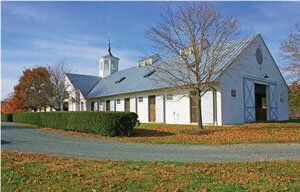
Must like horses: The barn's the thing at Chapel Springs.
CAAR MLS PHOTO
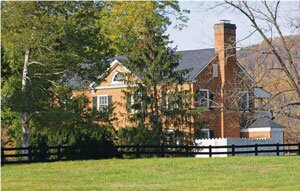
One of three houses on the property.
CAAR MLS PHOTO
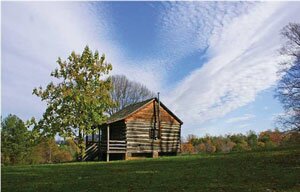
Every great estate should have a log cabin somewhere on the grounds.
CAAR MLS PHOTO
Chapel Springs
PRICE: $13,500,000
LOCATION: 2789 Chapel Spring Lane
SQUARE FOOTAGE: 2,500
ACRES: 1,478
ASSESSMENT: $2,600,100
OWNER: Chapel Springs Family LLC
AGENT: Jim Faulconer, McLean Faulconer
FEATURES: Million-dollar horse barn, lots o' riding trails.
DISH: It was known as Burning Daylight Farm when Halsey Minor put the property on the market for $19.5 million in 2003. Concrete magnate Wick McNeely bought it in 2005, and signed a $16.08 million deed of trust. On this property, the horse barn is more valuable than the 1989-built 2,500-square-foot house.
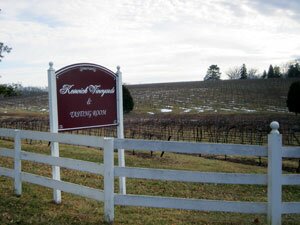
Turnkey vineyard and winery are part of the package.
PHOTO BY LISA PROVENCE

The 1911 manor "exudes" classic detail, according to the listing.
CAAR MLS PHOTO
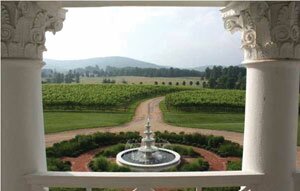
Stop and smell the grapevines from the second-floor porch.
CAAR MLS PHOTO
Edgewood
PRICE: $12,500,000
LOCATION: 6131 Gordonsville Road, Keswick
SQUARE FOOTAGE: 9,500
ACRES: 393
ASSESSMENT: $3,758,300
OWNERS: Al and Cindy Schornberg
AGENT: Frank Hardy, Frank Hardy Inc.
FEATURES: Keswick Vineyards comes with the sale.
DISH: Director Hugh Wilson sold Edgewood in 2002 for $5.1 million. When the Schornbergs planted grapes, some of the neighbors had a hissy fit about this particular agricultural use. Located across the street from Castle Hill.
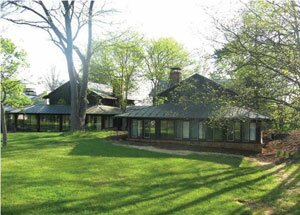
Keepers is the only contemporary offering in the $10-plus million range.
CAAR MLS PHOTO
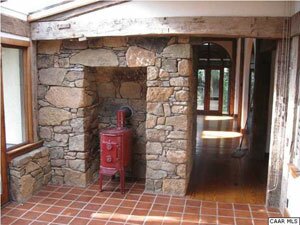
Don't worry– there are more heating options.
CAAR MLS PHOTO
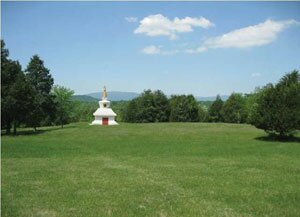
It's easy to forget you're still in Albemarle County– and only a hop, skip, jump from town.
CAAR MLS PHOTO
Keepers
PRICE: $10,825,000
LOCATION: 1000 Ivy Creek Drive
SQUARE FOOTAGE: 4,241
ACRES: 63
ASSESSMENT: $1,889,100 for 25 acres
OWNER: Two Stumbling Brandos LLC
AGENT: Ross Stevens, Stevens & Co., and Murdoch Matheson, Frank Hardy Inc.
FEATURES: Contemporary with three bedrooms and three baths behind Farmington. Stupa temple.
DISH: Former newspaper man Tom Worrell built this Shelter and Associates post-and-beam house in 1980, and for a while it housed Buddhist monks. Now it's in the most exclusive close-in development, five minutes from St. Anne's-Belfield. Reliable sources say Dave Matthews owns the property, but agent Stevens refuses to confirm, stating only it's owned by Two Stumbling Brandos LLC.
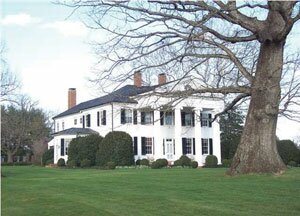
Seven Oaks, too, is a historic landmark on the western side of the county.
CAAR MLS PHOTO
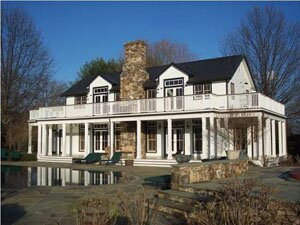
Vanishing edge pool and poolhouse.
CAAR MLS PHOTO
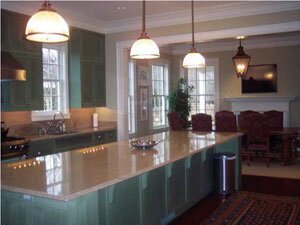
What scrumptious meals did Coran Capshaw whip up in this kitchen?
CAAR MLS PHOTO
Seven Oaks
PRICE: $10,500,000
LOCATION: 200 Seven Oaks Farm, Greenwood
SQUARE FOOTAGE: 6,870
ACRES: 100
ASSESSMENT: $4,328,000
OWNER: Seven Oaks Farm LLC
AGENT: Ross Stevens, Stevens & Company
FEATURES: National Register of Historic Places and Virginia Historic Landmark. Greek Revival with spacious pool house, studio, gym, stables and vineyard.
DISH: By the time magnate Coran Capshaw bought the 1847-built manse in 2000 for $2.25 million, the seven oaks were pretty much gone except for one sickly survivor. He rehabbed the place in 2001 and put it back on the market a year ago for $12.5 million.
Conservation easements: Protect– and profit
BY LISA PROVENCE
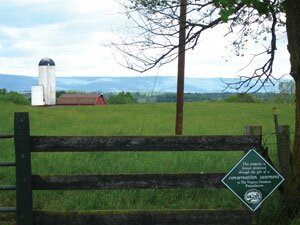
Conservation easements protect thousands of acres in the Piedmont– and provide tax benefits.
PHOTO COURTESY PIEDMONT ENVIRONMENTAL COUNCIL
What's the theory behind giving tax breaks to wealthy property owners who decline to create subdivisions on their rolling acres?
"A conservation easement is going to lower the fair market value," explains attorney Fred Payne.
Of the 10 priciest offerings in Albemarle, only four– Albemarle House, Georgetown Farm, Emerald Hills and Keepers– are not held in a conservation easement, something that keeps Albemarle green and puts extra green in the pockets of the owner.
According to Rex Linville at Piedmont Environmental Council., Albemarle County has more than 81,000 acres permanently protected, 5,100 of them gaining protection last year. (The number includes Biscuit Run, which– though not technically in a conservation easement– was sold to the Commonwealth of Virginia for a state park in a deal offering the same Virginia income tax credits that conservation easement holders get.)
A conservation easement is a legally binding agreement that limits future development of the property so those pastures remain dotted with horses and not subdivision houses. And such an easement can be very appealing to the rich looking to ease the annual tax bite.
For example, say a $10-million farm put under easement now has a market value of $7 million.
"In essence, they just gave a charitable gift worth $3 million," says Linville. On the federal income tax level, that $3 million counts as an income tax deduction– with certain restrictions. Meanwhile, Virginia gives a 40 percent income tax credit for the $3-million loss of value, which translates to a $1.2 million income tax credit.
"One of the nice things is they're transferrable to other Virginia taxpayers," says Linville. "One of the reasons we've been able to capture more moderate- and lower-income landowners is because of the ability to take advantage of that."
There's also a real estate tax benefit from here to eternity.
"I downplay that," says Linville. "They're already taking the land use tax rate." (In Albemarle, property used for agricultural purposes can be taxed at a much lower rate.)
According to Linville, putting property into a conservation easement purely for financial reasons doesn't really add up.
"The main reason to do it is to preserve the land," he says. "And the tax incentives are great."
And while it lowers the fair market value, that doesn't seem to have hurt the four $10-million-plus properties for sale around Keswick, all of which are under conservation easement.
"That's probably one of the most highly protected stretches in the Piedmont," says Linville. And that protection from small-lot subdivisions, he adds, "only makes the area more desirable."
#
10 comments
Who is more deluded: the sellers or the Realtors? If the Realtors say the sellers are setting the prices, then the Realtors are complete fools to be taking the listing, as it denigrates their credibility.
The rich got poorer in the financial meltdown just like the middle class. Nobody's buying estates these days, nobody is buying hobby vinyards, and Albemarle County is no longer a destination for fake farmers.
Notice how many of these places have changed hands in the past decade? These places aren't worth more than the previous selling price, even with improvements. Game over. Losers holding the bags.
Slow news week? How about some real reporting on the rising rate of personal bankruptcies? The rising number of "short sales" and foreclosures listed for sale?
How about some real reporting on why so many people are jealous of the rich.
Everyone hates the rich until a long lost uncle dies...
Uh, so Albemarle is millions in the Red, and apparently people are selling homes for almost ten times the assessment? Hmm... Seems like the tax assessors are not doing their job.
In the name of affordable housing, I say that from the moment your home hits the MLS we should tax your property at that value. After all, if you think it's really woth that much then maybe you should be paying higher taxes on it? (Or to be fair, lower taxes if the situation is reversed...) Might put a cap on some of the over zealous sellers.
maybe they should charge dirt worshipper on the suggested reatial price on anything he buys....
Once the property is sold the new price becomes the assessment.
these people pay plenty of taxes... The only difference is that other than the fire department they get less than you from the government since they send their kids to private schools and probably never set foot in the library.. and other than Halsey minor will probably never need food stamps.
why not do appraisals and not assessments for these high dollar properties and use that to base their real estate taxes on? also drop the land use/conservation/tax credit savings plan they get now. alb cty needs money to meet its' deficit and it's time to look toward these wealthy landowners to pay their fair share! if they can afford to own these properties, they can afford to pay the true taxes on them. i'm tired of paying more taxes on my home and couple of acres than the guy down the street who owns a farm with a nicer house than i have and a lot more land! i don't care where he sends his kids to school - he's still going to dial the same 9-1-1 number for help and drive on the same roads i do. it's time for alb cty to do away with these perks for wealthy landowners.
Kinloch, their neighbor Castle Hill AND the farm across the street from them for sale--and those are just the ones this article mentions. How in their right mind would buy in a neighborhood where every house is for sale? No matter what the price.
comment .. you are so WRONG it isn't even funny.
You do NOT pay less taxes than anyone who has a nicer house than you. ALL homes are assesed at face value, and that includes the surrounding two acres. The rest of the farm land is assesed diffently for many practical reasons that helps the county and the taxpayers.
So you want the rich to pay their fair share?
Well if you have a couple of kids in the school system at 10,500 EACH then you SPEND 21K of taxpayer money on your kids. Meanwhime the "rich" guy send hid kids to private and consumes none of that.
If your tax bill were 21k then your little house would be worth about 25 million.
Why don't YOU pay YOUR fair share?
You may hate others beig wealthy nut I doubt you would turn down an inheiritance from a long lost uncle.
re:"Once the property is sold the new price becomes the assessment."
This is not true AT ALL. The person making this statement is ignorant of how tax assessment is done.
I use to play golf and work with the many of the estate owners in both Keswick and Greenwood. 20 yrs. ago the large estates were owned by old money families. The ones that had the money to also be into Thorough bred horse racing or anything else they wanted. They never wanted any notoriety or publicity. They came to Albemarle to get away from that in N.Y. and Palm Beach and lived rather conservitavly. You couldn't tell who had money, because the truly wealthy never flawted it. Today you've got the newer money that sees the nice rolling hills and the manicured laws and have no idea the cost that is required to mantain these estates. That cost has soared in the last decade with employment taxes, insurance and epa standards. After a year of either being tied to these things or trusting a farm manager with a great deal of money they are ready to throw in the towel and move to a gated community. If you knew how much even these Mcmansions have to pay every month in taxes makes you wonder whether it's worth the curb appeal or not. Who among us could imagine paying over %5000 a month for the privaledge of living in your own house.
Dreadful article...Lisa must be either hungover or coming down with something.